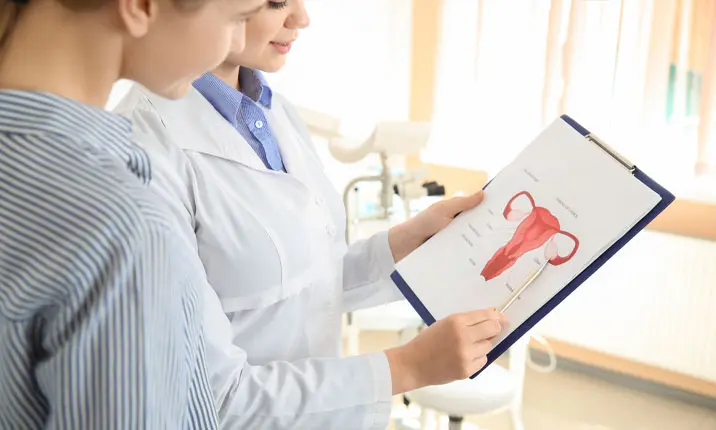What is uterine prolapse?
A uterine prolapse is when the uterus drops into the vaginal canal because the pelvic muscle, tissue and ligaments are unable to support its weight. This can also affect other organs such as the bladder or rectum. Collectively, this is known as pelvic organ prolapse.
Muscle weakness or relaxation may allow the uterus to sag or completely come out of the body in various stages:
- 1st Degree: The uterus drops into the upper half of the vagina
- 2nd Degree: The uterus drops nearly to the opening of the vagina
- 3rd Degree: The uterus protrudes out of the vagina
- 4th Degree: The uterus is completely out of the vagina
How common is uterine prolapse?
Uterine prolapse is a common condition. The risk of developing the condition increases with age, due to the natural loss of the hormone oestrogen. Multiple vaginal deliveries during childbirth also increases the risk of having a uterine prolapse.
Risk factors of uterine prolapse
Risk factors for uterine prolapse include:
- Natural (vaginal) childbirth
- Obesity
- Chronic constipation
- Age
- Family history
Complications of uterine prolapse
Uterine prolapse is often associated with prolapse of other pelvic organs. These include:
- Anterior prolapse (cystocele). Bulging of the bladder into the vagina due to weakness of connective tissues separating the bladder and vagina. This is also called a prolapsed bladder.
- Enterocele. Bulging of the small intestine into the vagina. This condition is also called a small bowel prolapse.
- Posterior vaginal prolapse (rectocele). Bulging of the rectum into the vagina due to weakness of connective tissues separating the rectum and vagina.
Severe uterine prolapse can displace part of the vaginal lining, causing it to protrude outside the body. When vaginal tissue rubs against clothing, vaginal sores or ulcers can occur.
How to prevent a uterine prolapse?
While uterine prolapse cannot be definitively prevented, although lifestyle changes can help you reduce the risks. These include:
- Maintaining a healthy body weight
- Eating a fibre-rich diet to avoid constipation
- Quitting smoking
- Performing pelvic floor exercises to strengthen the pelvic muscles
- Avoiding activities that place extra pressure on your pelvic organs such as heavy lifting
Symptoms of a prolapsed uterus
Prolapse occurs in stages. In mild cases, the uterus may have only dropped slightly and may not require treatment. In severe cases, the uterus has dropped significantly or may be protruding from the vagina. Some women experience no symptoms while others may notice the following:
- Leakage of urine (urinary incontinence)
- Being unable to completely empty the bladder
- Constipation
- Feeling weight or pressure in the pelvis or vagina
- Bulging in the vagina or protruding tissue from the vagina
- Lower back pain
Causes of a prolapsed uterus
Uterine prolapse happen when the group of muscles and ligaments that hold the uterus in place weaken, resulting in the uterus dropping into the vagina. Uterine prolapse is more likely to happen to women who have:
- Had vaginal childbirth, especially those with multiple births or if the baby was large (>4kg)
- Experienced injury during childbirth or a complicated and prolonged pushing phase during delivery
- Loss of muscle tone as a result of ageing
- Weakening and loss of tissue tone after menopause
- Conditions leading to increased pressure in the abdomen such as chronic cough, constipation, pelvic tumours or accumulation of fluid in the abdomen
- Increased weight (overweight or obese)
- Had major surgery in the pelvic area
- A family history of the condition
Uterine prolapse diagnosis
To check if you have uterine prolapse, a doctor will perform a pelvic examination. You may also be asked to bear down or exert pressure as though you are trying to perform a bowel movement or to tighten your pelvic muscles as though you are trying to stop the flow of urine.
Additional tests may be required such as a cystoscopy to check the bladder and urethra or a magnetic resonance imaging (MRI) of the kidneys, uterus and other pelvic organs. These will help the doctor to determine if you have a uterine prolapse and how mild or severe it is.
Uterine prolapse treatment
Non-surgical options
- Exercise. In cases of mild uterine prolapse, performing Kegel exercises to strengthen your pelvic muscles may be the only intervention that is needed. To do Kegel exercises, tighten your pelvic muscles as if you're trying to hold back urine. Hold the muscles tight for a few seconds and then release. Repeat 10 times.
- Vaginal pessary. A vaginal pessary is a rubber or plastic ring that fits around or under the cervix, which is the lower part of the uterus. This device helps to support the bulging tissues and hold the uterus in place.
Surgical options
- Hysterectomy. Uterine prolapse may be treated by removing the uterus. This may be done through a cut made in the vagina (vaginal hysterectomy) or through the abdomen (abdominal hysterectomy)
- Prolapse repair without hysterectomy. This surgery is generally done through the vagina or the abdomen. It involves putting the uterus back into its normal position by reattaching the pelvic ligaments to the lower part of the uterus to hold it in place.
Hysterectomy procedure
Depending on your condition, your doctor may recommend one of the following:
- Partial hysterectomy (also known as a supracervical or subtotal hysterectomy) which removes the upper part of the uterus and leaves the cervix in place
- Total hysterectomy which removes the entire uterus including the cervix
- Radical hysterectomy which removes the uterus and all the surrounding structures
These procedures may be minimally invasive, such as laparoscopy, while others that take place through the vagina or abdomen are not. Here are some of the likely treatment options your specialist may advise.
Vaginal hysterectomy
In a vaginal hysterectomy, the uterus is removed through the vagina without the need for an abdominal incision. This procedure generally has fewer complications and a shorter healing period, making it a preferred choice whenever possible. However, it may not be suitable for all women.
Laparoscopic hysterectomy
A laparoscopic hysterectomy requires several small incisions in the abdomen. Through these incisions, a laparoscope (a small camera) can be inserted so the surgeon can view the pelvic organs and concurrently remove the affected part of the uterus using the same scope. It has a lower risk of infection compared to an abdominal hysterectomy and requires a shorter hospital stay. However, the procedure may take longer to perform and can pose an increased risk of injury to other surrounding organs.
Abdominal hysterectomy
An abdominal hysterectomy means that the uterus is removed through an incision in the lower abdomen. Compared to a laparoscopic or vaginal hysterectomy, there is a greater risk of complications, with a longer healing time.
Hysterectomy side effects
Pain, bleeding, vaginal discharge and constipation are commonly experienced after a hysterectomy. Other side effects a person may experience depends on the type of hysterectomy they have.
Hysterectomy without oophorectomy
This procedure does not involve ovary removal but may still affect the ovaries. Research indicates that the onset of menopause may be sped up as a result of the surgery. However, more research needs to be done to confirm the long-term effects and impact of hysterectomies on ovarian function.
Hysterectomy with oophorectomy
This procedure involves the removal of both the uterus and the ovaries. The ovaries produce the female hormones oestrogen and progesterone. Without these organs, a woman would experience menopause symptoms such as hot flashes, night sweats, vaginal dryness, difficulty sleeping, mood swings, weight gain, hair loss and dry skin.
The duration of these symptoms will vary from person to person. Your doctor may recommend hormone replacement therapy to manage these symptoms.
How to prepare for hysterectomy surgery
You will receive specific instructions from your healthcare provider on how you should prepare for the surgery. Generally, the instructions would include:
- Fasting. Patients will often be told not to eat or drink anything after midnight on the eve of their surgery.
- Dress comfortably. Wear comfortable shoes and loose-fitting clothing to the hospital. Do not wear makeup and leave all your jewelleries at home.
- Inform your doctor if you are on any medications. To prevent surgical complications, be sure to inform your doctor all the medications you are taking, including prescription and over-the-counter drugs and supplements.
- Reschedule the procedure if you're sick. Tell your doctor if you don't feel well on the day of the procedure. Illnesses that affect your respiratory system, like pneumonia or the flu may be a reason to delay the procedure.
Hysterectomy recover time
Your stay in the hospital and subsequent recovery will vary according to the type of procedure, the extent of surgery and your overall health. Pain will be experienced for the first few days, with vaginal bleeding and discharge. You will also be asked to walk about as soon as you are able, as it will help prevent blood clots from forming in the operated area. You may also receive medication to relieve pain and prevent clots.
During your recovery, you should aim to get plenty of rest in between moving around as often as possible, such as taking short walks and gradually increasing the distance. You should avoid lifting anything heavy until your doctor says you are able to. In the first 6 weeks, do not place any object in the vagina such as douches or tampons, and avoid sexual intercourse.
It's important to follow your doctor's instructions regarding post-operative care, and this includes medications to take, diet to observe and physical activity. You should also keep up with routine gynaecological check-ups to detect any other potential or long-term complications.
Who can you see for more information?
A uterine prolapse, left untreated, may worsen to the point where it causes pain or affects other organs, and interfere with bowel and/or bladder function. If you experience any of the symptoms above or suspect any abnormality, please seek advice from a gynaecologist to discuss your treatment options.















